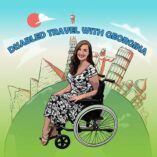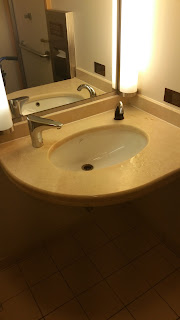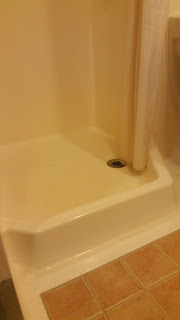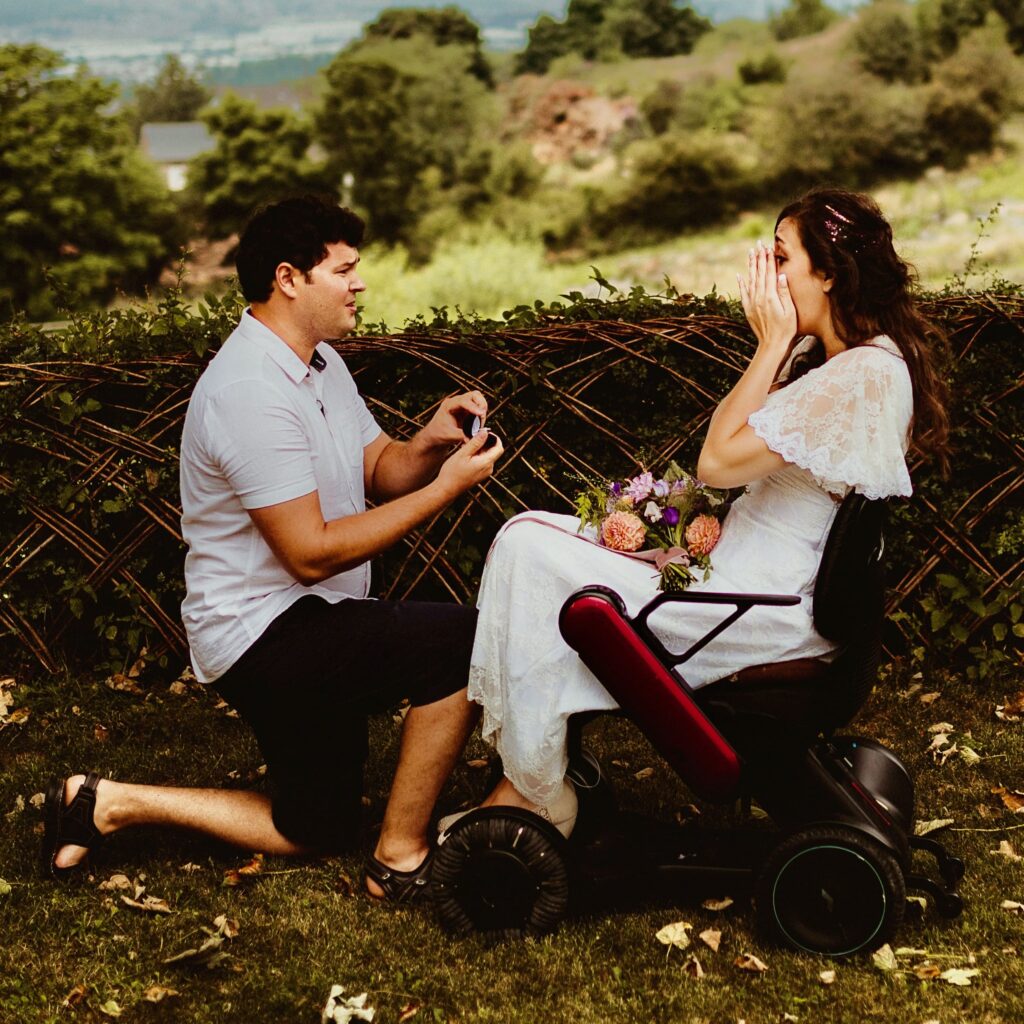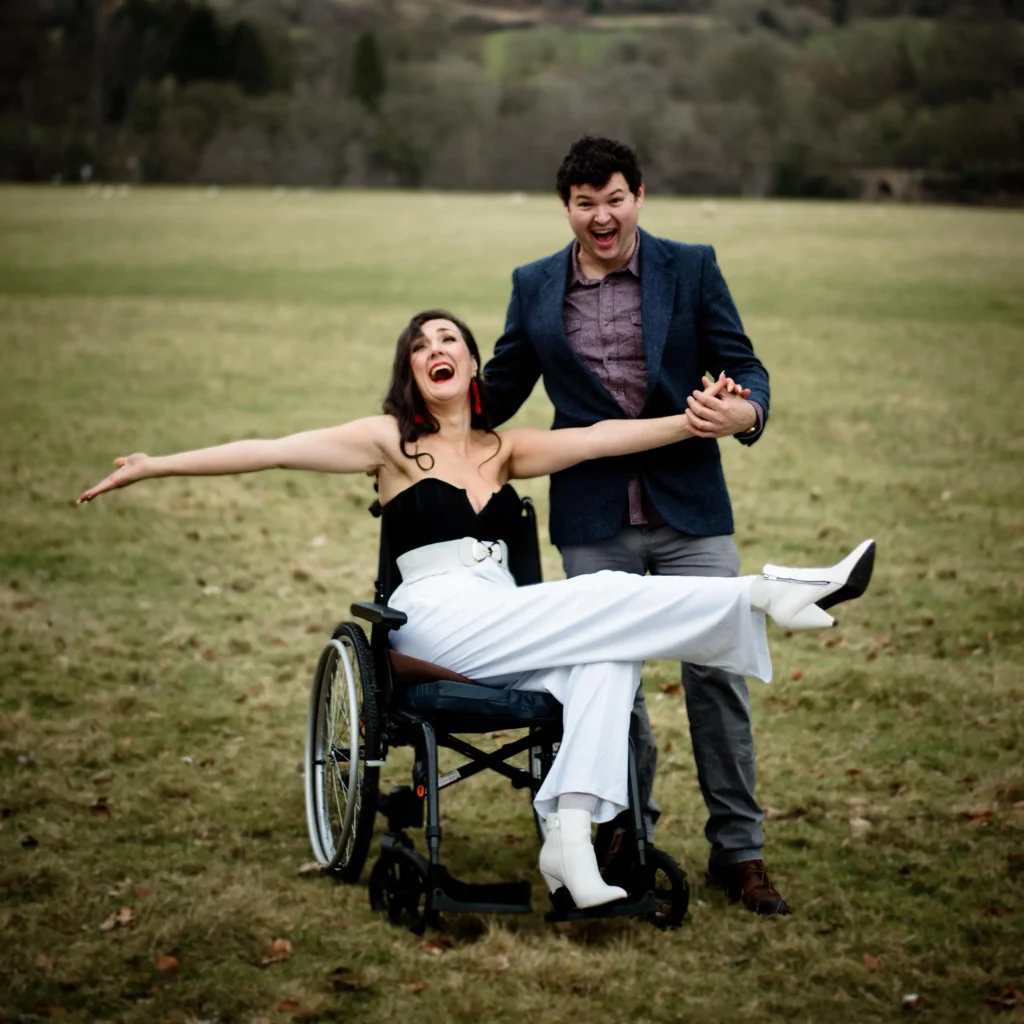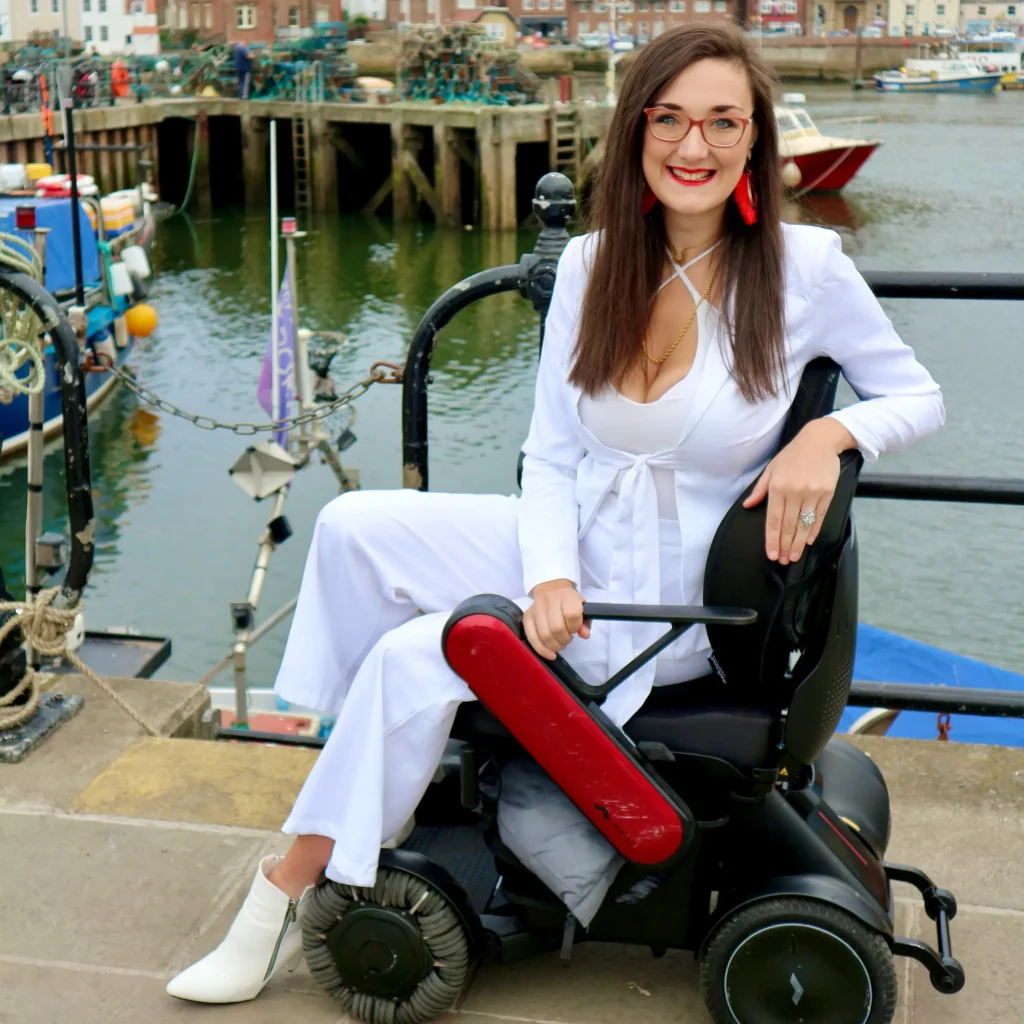This is part of the fun of a cruise as it allows you to relax in the sunshine. These areas are particularly busy on sea days when the ship isn’t in port so make sure to grab your sunbed early enough! There were signs everywhere that sunbeds can’t be reserved whilst out of use for thirty minutes or more but this wasn’t particularly enforced until late in our cruise. They added a cardboard tag to out of use chairs and then removed belonging off of chairs to a table at the back of the sunbed area. Sunbeds in all areas are particularly difficult to access for people in a wheelchair since they are placed too close together often for a chair to be wheeled through. You could often only access certain beds where there were openings between beds. On deck 14 we often found that sunbeds could only be got onto from the very base as they were situated very close to each other which is fine if you can easily “shuffle” up from the base but is a problem if not. 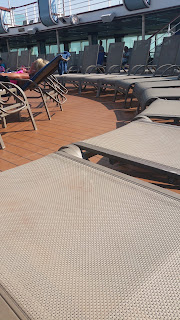
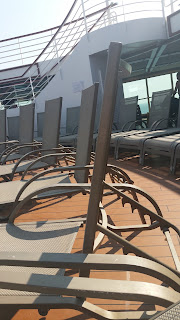 There are multiple pools on Ventura for able-bodied and disabled cruise passengers and some are adult only whilst some allow under 18s in. This includes the Oasis (paid entry spa) pool which has eight steps to enter. Access for both adults and under 18s is permitted to the Laguna outdoor pool which has seven steps, the Beechcomber pool with a hoist (as detailed below) and the outdoor Terrace pool. Children have access to the smaller Plunge pool (four steps and a ladder) and Splash pool (one step and a ladder). Although, poolside help if available for both able-bodied and disabled P&O cruise passengers during high summer season. More details of the Ventura pools are below. The Laguna Pool is the largest of the pool areas and is in the centre of the ship. This pool is open-air and has no cover. It has a shower area attached to the pool to rinse that sweat and suncream off before entering the pool. The big problem with this pool is that there are three tall steps to climb or a short wall raised around this area that people sit on to watch their children play. This is a lovely pool area to relax by since they have music playing at most times and live music and quizzes at the times specified in your Horizon daily newspaper which is delivered to your cabin. Obviously, if your mobility is good then you can climb these steps with no problem but otherwise this is just a nice area to relax in.
There are multiple pools on Ventura for able-bodied and disabled cruise passengers and some are adult only whilst some allow under 18s in. This includes the Oasis (paid entry spa) pool which has eight steps to enter. Access for both adults and under 18s is permitted to the Laguna outdoor pool which has seven steps, the Beechcomber pool with a hoist (as detailed below) and the outdoor Terrace pool. Children have access to the smaller Plunge pool (four steps and a ladder) and Splash pool (one step and a ladder). Although, poolside help if available for both able-bodied and disabled P&O cruise passengers during high summer season. More details of the Ventura pools are below. The Laguna Pool is the largest of the pool areas and is in the centre of the ship. This pool is open-air and has no cover. It has a shower area attached to the pool to rinse that sweat and suncream off before entering the pool. The big problem with this pool is that there are three tall steps to climb or a short wall raised around this area that people sit on to watch their children play. This is a lovely pool area to relax by since they have music playing at most times and live music and quizzes at the times specified in your Horizon daily newspaper which is delivered to your cabin. Obviously, if your mobility is good then you can climb these steps with no problem but otherwise this is just a nice area to relax in. The Beechcomber pool is the pool where there is a mechanical glass ceiling which can be opened or closed depending on the weather conditions. This has a special sunbed area for guests with mobility impairments and hoist chair for entering the pool. You transfer onto this plastic chair which clicks into place, swivels around so your body is over the water then lowers you down. I actually didn’t use this service as this pool was consistently busy and I worry with my nerve injury about a child accidentally kicking this area. However, this is a wonderful service and will allow some people to use the pool when they otherwise couldn’t have.
The Beechcomber pool is the pool where there is a mechanical glass ceiling which can be opened or closed depending on the weather conditions. This has a special sunbed area for guests with mobility impairments and hoist chair for entering the pool. You transfer onto this plastic chair which clicks into place, swivels around so your body is over the water then lowers you down. I actually didn’t use this service as this pool was consistently busy and I worry with my nerve injury about a child accidentally kicking this area. However, this is a wonderful service and will allow some people to use the pool when they otherwise couldn’t have.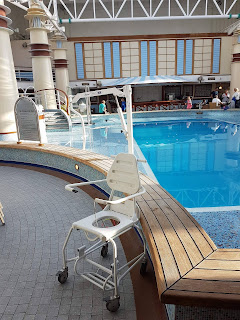
I didn’t personally use the other pool areas but am happy to answer any questions about these via DisabledTravelWithGeorgina@gmail.com. The lift to the Oasis pool was broken during our cruise which was highly frustrating as it really limited our sunbed access and I couldn’t go into the paid spa. Although, disabled P&O cruise passengers need to book into the private Oasis area as soon as they board the ship to allow them to pay for any free slots as this was fully booked up during our stay! Disabled ToiletsThese were located across the ship and were often located in areas where many people would congregate, for example, outside of restaurants and theatre areas. The map you are given upon embarkation shows them clearly with a little wheelchair sign. These were spacious with a lowered sink and metal bars to help pull yourself up on. We encountered no problems except the small metal lip over the door jamb which gave you a small jolt to enter. 
CabinsHow many disabled cabins are there on Ventura? There are 31 dedicated disabled cabins on Ventura but these often sell out very quickly. If you are looking at booking on ‘Early Saver Rate’ where you can’t choose a cabin then many travel companies charge extra to book a disabled cabin whilst P&O won’t if you book with the directly. This is worth looking at when you compare prices. We stayed in a normal interior cabin (no window/ balcony) as we thought my mobility would be better than it was when we sailed. The doorway was too narrow for a wheelchair to enter without collapsing. To remedy this I walked a couple of metres between the corridor and into the cabin and then unfolded the wheelchair to use within the cabin. I couldn’t manage steps so ended up using disabled toilets around the ship and showering in the spa’s disabled shower rather than using the bathroom in the cabin. There are pictures below of the step into the bathroom and then the step into the shower. 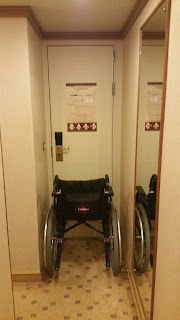
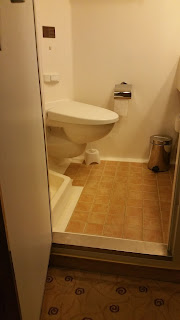 It’s definitely worth asking for a disabled cabin if you struggle with these steps. Disembarkation and TenderingThe tannoy system which announces your arrival into port is really helpful for disabled cruise passengers as it announces a special gangway for passengers with reduced mobility. This is helpful because it is slightly less steep than the “normal” gangway. I found disembarkation hard due to my nerve damage as you were bounced down raised ridges that were put in place to stop the wheelchair from running away from itself. The design hurt me a lot but made sense to safely disembark. Sometimes a large cruise ship can’t fit into smaller ports so P&O cruises use “tenders” which are the smaller lifeboats that ferry you to and from the port. You have to pass a mobility assessment to tender when you get on the ship (the place and time is delivered to your cabin at the start of the cruise). This mobility assessment shows you can climb steps and step over a gap of 45 centimetres or 18 inches. If you are a child you can be carried over this gap.
It’s definitely worth asking for a disabled cabin if you struggle with these steps. Disembarkation and TenderingThe tannoy system which announces your arrival into port is really helpful for disabled cruise passengers as it announces a special gangway for passengers with reduced mobility. This is helpful because it is slightly less steep than the “normal” gangway. I found disembarkation hard due to my nerve damage as you were bounced down raised ridges that were put in place to stop the wheelchair from running away from itself. The design hurt me a lot but made sense to safely disembark. Sometimes a large cruise ship can’t fit into smaller ports so P&O cruises use “tenders” which are the smaller lifeboats that ferry you to and from the port. You have to pass a mobility assessment to tender when you get on the ship (the place and time is delivered to your cabin at the start of the cruise). This mobility assessment shows you can climb steps and step over a gap of 45 centimetres or 18 inches. If you are a child you can be carried over this gap.  EntertainmentThere is often music playing in bar or social areas both day and night; this which was very atmospheric but may cause a problem for people with autism depending upon severity. None of the performances were signed for the deaf and I was not made aware of any hearing loop system in place. The Gala theatre used for most on-ship performances both by artists bought in for certain nights and for the Headliners Theatre Company who produce exceptional shows and are resident on the ship. During the day this is often used as a cinema to show films. The Gala Theatre is on two levels and there is reserved disabled seating on both of these floors. The upper floor is tiered and has steps down each side and the centre but there is a bank of disabled seating at the very back. This bank of disabled seats seem very far from the stage and the view is very restricted. The lower floor is not tiered but the view is often better for less able-bodied passengers. The end seat of each row is reserved for mobility impaired passengers and their companions. These seats do mean you have to stand and sit regularly if you are early to a performance to let fellow passengers into the centre of each row so perhaps don’t transfer from your wheelchair into the normal seat until the last minute if you struggle with this action like me.
EntertainmentThere is often music playing in bar or social areas both day and night; this which was very atmospheric but may cause a problem for people with autism depending upon severity. None of the performances were signed for the deaf and I was not made aware of any hearing loop system in place. The Gala theatre used for most on-ship performances both by artists bought in for certain nights and for the Headliners Theatre Company who produce exceptional shows and are resident on the ship. During the day this is often used as a cinema to show films. The Gala Theatre is on two levels and there is reserved disabled seating on both of these floors. The upper floor is tiered and has steps down each side and the centre but there is a bank of disabled seating at the very back. This bank of disabled seats seem very far from the stage and the view is very restricted. The lower floor is not tiered but the view is often better for less able-bodied passengers. The end seat of each row is reserved for mobility impaired passengers and their companions. These seats do mean you have to stand and sit regularly if you are early to a performance to let fellow passengers into the centre of each row so perhaps don’t transfer from your wheelchair into the normal seat until the last minute if you struggle with this action like me. Port DaysWhen booking P&O excursions make sure to look carefully at their symbol key system which lets you know the degree of mobility you have to have. There is a dedicated disability team at the excursions desk so if you ring the main P&O line and ask to be transferred to them then you can get a more tailored service. Note that P&O excursions (as with most cruise companies) are overpriced and you will be in a large group. Please check out my pages on the ports that I travelled to. I also run a very reasonably priced consultation service where I can plan your port days fully according to your specific requirements; please DisabledTravelWithGeorgina@gmail.com for more details. If you prefer to go solo then do note that on Early Saver fare you don’t get P&O shuttle buses included in the fare. This means that you will have to either use your own transport between the ship and the town or pay to use P&O shuttles (normally around £5 per person each way). If you book on the normal fare where transfers are included then P&O is obliged to give you a free taxi if the shuttle bus is not wheelchair accessible. Do make sure to do your research though as we found with many ports that a taxi or wheelchair friendly local bus was the most cost-effective solution especially when sharing with a group – an easy way for you to make friends! OverallOverall, cruising is still a viable option for most disabled passengers despite some clear set-backs. If you go on the cruise knowing these than you know exactly what to expect. This is why my tailored holiday consultancy for both abled and disabled passengers is so popular as it will give you a detailed understanding of what to expect on your holiday; I can even book anything from museum entry to taxi services to use. Disabledtravelwithgeorgina@gmail.com for more details. Each ship has a point of contact especially for disabled passengers so if you need to ask about anything onboard the ship or complain then it is always best to ask to speak to her/ him if the Reception Desk cannot help you. Through raising my concerns and due to the change of one port from docking to tendering (and there’s not a chance I would pass the tender assessment!), I was given a free restaurant meal and bottle of wine. Please don’t complain over nothing but if you have legitimate concerns then please let someone know so hopefully other passengers’ experiences can be improved.
Port DaysWhen booking P&O excursions make sure to look carefully at their symbol key system which lets you know the degree of mobility you have to have. There is a dedicated disability team at the excursions desk so if you ring the main P&O line and ask to be transferred to them then you can get a more tailored service. Note that P&O excursions (as with most cruise companies) are overpriced and you will be in a large group. Please check out my pages on the ports that I travelled to. I also run a very reasonably priced consultation service where I can plan your port days fully according to your specific requirements; please DisabledTravelWithGeorgina@gmail.com for more details. If you prefer to go solo then do note that on Early Saver fare you don’t get P&O shuttle buses included in the fare. This means that you will have to either use your own transport between the ship and the town or pay to use P&O shuttles (normally around £5 per person each way). If you book on the normal fare where transfers are included then P&O is obliged to give you a free taxi if the shuttle bus is not wheelchair accessible. Do make sure to do your research though as we found with many ports that a taxi or wheelchair friendly local bus was the most cost-effective solution especially when sharing with a group – an easy way for you to make friends! OverallOverall, cruising is still a viable option for most disabled passengers despite some clear set-backs. If you go on the cruise knowing these than you know exactly what to expect. This is why my tailored holiday consultancy for both abled and disabled passengers is so popular as it will give you a detailed understanding of what to expect on your holiday; I can even book anything from museum entry to taxi services to use. Disabledtravelwithgeorgina@gmail.com for more details. Each ship has a point of contact especially for disabled passengers so if you need to ask about anything onboard the ship or complain then it is always best to ask to speak to her/ him if the Reception Desk cannot help you. Through raising my concerns and due to the change of one port from docking to tendering (and there’s not a chance I would pass the tender assessment!), I was given a free restaurant meal and bottle of wine. Please don’t complain over nothing but if you have legitimate concerns then please let someone know so hopefully other passengers’ experiences can be improved.
